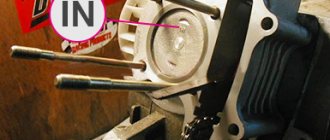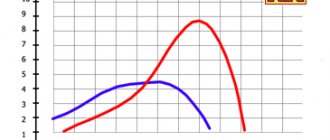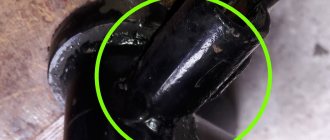The cylinder-piston group (CPG) of a scooter engine is the same replaceable part of the vehicle as any other. Metal fatigue under natural operating conditions, road accidents and other unfavorable situations lead to the need to replace pistons. The ability to move stably directly depends on the serviceability of the element:
- the presence of pistons in good condition allows you to start the engine without sudden heating;
- the optimal level of pressure in the internal combustion engine allows fuel to be consumed in normal quantities;
- The amount of emissions into the atmosphere through the exhaust pipe also depends on the serviceability of the pistons.
Changing your scooter's CPG reduces oil costs and increases the overall life of the vehicle's engine. It is especially important to watch for signs of needing repairs during particularly active trips and temperature changes.
To fix a broken piston group, you will need to open the scooter, which is carried out in a standard sequence for almost all brands and models with minor differences in design. Many users carry out repairs without taking into account small parts, which is why piston rings and valves quickly become unusable. The following instructions will help you carry out all work safely and efficiently.
Signs of a CPG malfunction
To determine the breakdown of the piston group, you do not need to have complex measuring instruments. It is enough to pay attention to the following symptoms:
- the ringing of piston rings is heard;
- The scooter does not start on the first try. You have to perform the operation several times to achieve the result;
- rapid emptying of the gas tank due to excessive fuel consumption;
- noises are heard in the cylinder/motor that were not there;
- the vehicle operates unstably at idle speed;
- general reduction in power;
- sudden shutdown.
Additional signs include too much smoke and lack of resistance when trying to start the scooter's engine. After disassembling (detailed list of actions below) the motor can be seen on the piston cylinder with black traces - this is carbon deposits. This indicates a loose fit of the pistons to the cylinder walls, as a result of which gases constantly escaped from the inside, which reduced the overall pressure.
Old piston with signs of carbon deposits
In the case of a four-stroke engine, the signs of a CPG failure are slightly different:
- presence of thick black/blue smoke;
- increased oil consumption;
- change in power (this indicator can only be determined during diagnostics, since on a 4-stroke engine the change in parameter may not be immediately noticeable);
- inability to start the scooter the first time even with a cold engine.
If these problems are observed, it makes sense to disassemble the vehicle in order to reduce repair costs in the future due to malfunctions of other parts caused by the lack of replacement of the CPG.
Scooter tuning - intake pipe tuning
| The gasoline-air mixture prepared by the carburetor then flows into the crankcase through the inlet pipe. This part is sometimes mistakenly called a manifold, which is incorrect, since this pipe does not collect anything, but only directs the mixture into the crankcase. It is important that the flow area of this part is no less than the size of the carburetor, otherwise there is no point in installing a carburetor! The flow area of the standard pipes on most scooters is such that you can easily use a 17.5 mm carburetor instead of the standard one. The same cannot be said about 19 mm carburetors! What can we say about such scooters, subjected to grief tuning with the help of 21 or even more carburetors without replacing the intake pipe!? Through tears, we call these “scooters named after the 19th carb”... An anecdote comes to mind: Stirlitz gave the dog gasoline and let him go. The dog ran 5 meters and fell. “The gasoline has run out,” thought Stirlitz. |
Preparation for the procedure
You need to start by cleaning the exterior of the scooter from dirt, sand, and dust. The work itself must be carried out indoors, where there is no risk of debris getting inside the mechanisms from the outside. Operations may be carried out outdoors, but subject to the following conditions:
- the air temperature should be 18-25 degrees;
- little or no wind;
- the presence of a flat, hard surface for repairs - concrete or asphalt are best suited;
- It is not recommended to open the inside of the scooter for at least two hours after turning off the engine for safety reasons.
For fastening, you will need to prepare a box with cells for each type, so as not to lose or mix up the varieties. The work may take about an hour depending on your skill level. If you lack experience, it is better to call another person for help and carefully record what was removed (and in what sequence) in order to reassemble the vehicle correctly after everything.
Scooter tuning - impeller tuning
| If on one side the belt in the drive pulley rests against the variator, then on the other it rests against the impeller. The impeller got its name for the additional function it has - transmission cooling. Tuning impellers have larger blades, allowing them to operate with greater productivity. Considering the low price of this part, we can safely recommend it for purchase. Sometimes, when installed with an appropriate variator, the impeller allows for a larger operating radius of the drive pulley, for example in the case of the Polini kit for the Honda X8R scooter. |
How to install a piston on a scooter: remove the old one, install a new one
Getting to the piston cylinder will be easy if you follow the instructions. You need to start by removing the plastic lining of the scooter, and then disconnect the wires. The oil hose is disconnected, and the motor itself is removed by unscrewing the fasteners. The plastic cover should be set aside so as not to crush it due to careless movement.
To get to the piston, you ultimately need to remove the cylinder head, and then the cylinder itself.
Dismantling the piston itself is carried out in the following sequence:
- remove the CPG mounting bolts along with the head and gasket. Each bolt must be unscrewed in a criss-cross manner (diagonally) to avoid damaging the threads - installing the piston back requires using the same method. This will also prevent unwinding without the participation of the owner;
- directly dismantling the cylinder using upward movements - if you can’t pull it out, it is recommended to knock with a light wooden object. The product may become stuck due to the deposits listed above;
- turning the crankshaft for maximum piston lift. Be sure to cover the crankcase hole with a rag to prevent dirt from getting inside;
- you need to remove the retaining ring in order to remove the piston pin;
- In case of jamming, you need to use liquid to remove carbon deposits. An alternative is carburetor cleaner. As a result, after soaking, all plaque is easily removed, similarly with rings;
- cleaning ring grooves.
Step-by-step video on how to remove the piston from a scooter:
You will need to inspect the needle bearing for signs of burning, indicating wear of the part. If they are, a change is required immediately. Installation of a new CPG will not be effective for long in the absence of proper care.
Needle bearing
You should also pay attention to the following factors:
- if there is displacement of the needles inside the cage, the product as a whole is unusable;
- violation of geometry also indicates the need for replacement;
- There should not be much play when moving in the upper head of the connecting rod. In normal condition, the bearing simply moves freely.
As a result of changing the needle bearing, you can install a new piston for the scooter. Installation is carried out in reverse order. Several features of the procedure must be taken into account:
- Each new piston is supplemented with two rings (retaining rings), which allow the structure to be securely fixed. For four-stroke engines, the number of rings is already three due to the presence of an oil scraper ring;
- everything must be placed so that the rings and cylinder converge in the groove for reliable operation under any load;
- You should not put the plastic back before checking the functionality of the scooter;
- the upper part of the cylinder is indicated by the word “IN” on the cover - this way you won’t be able to confuse the direction;
- The inscription “EX” (exhaust) on the cover should be directed towards the exhaust port. Another option is to draw an arrow (it means the same thing). This factor depends on the specific scooter manufacturer.
Repairs can be carried out using a special kit containing all the necessary tools:
- piston ring remover (pliers);
- piston groove cleaning device;
- L-shaped screwdriver.
All this can be found separately. The main thing is to follow the dimensions that will suit a specific scooter model.
Step by step video on how to install a new piston on a scooter:
Scooter tuning - muffler tuning (exhaust system)
| A good exhaust system can easily help you add horsepower to your scooter. The operating features of a two-stroke engine are such that a well-chosen exhaust system can increase power by up to 20%, which is a very significant amount. Moreover, modern scooters, forced to meet the most stringent environmental requirements, are equipped as standard with exhaust systems that have a detrimental effect on performance. Exhaust systems, like cylinders, are divided into different classes, so you need to choose a system based on the piston system that will be used on the scooter. Sport class exhaust systems are quite versatile. Many of them show excellent results with both standard 50cc cylinders and 70cc Sport class cylinders. But not all, so you should be careful when choosing. Pipes from certain manufacturers have proven themselves to be extremely short-lived and fragile, so you should not buy the first pipe you come across. Chrome-plated exhaust systems deserve special attention: they retain their appearance much better and are also protected from corrosion, which is very important in Russian operating conditions! |
Scooter tuning - belt tuning
| The role of the belt in the transmission of a scooter cannot be overestimated. By connecting the drive and driven pulleys, it is the belt that transmits torque from the crankshaft to the gearbox mechanism. As you know, the belt on a scooter is a consumable item and wears out quite quickly. When tuning, the load on it increases, so the wear process accelerates. A variety of manufacturers, right up to the tire giant Continental, offer samples that are more wear-resistant than the standard one. Rigid Kevlar belts are not recommended for use with a standard CVT to avoid premature wear of the latter. The choice of belt should be approached very carefully, since according to the tests carried out, different belts can work completely differently in the same transmission. And sometimes, without appropriate settings, they can only worsen the dynamic and speed performance of the scooter. |
Scooter tuning - gearbox tuning
| What scooterists often complain about, even after a little tuning, is that they cannot reach the maximum speed. After all, when tuning the Sport class, the maximum engine speed increases quite slightly, which means that there is simply nowhere to get a significant increase in the maximum speed. However, the increased volume gives the motor more traction, which allows you to overcome hills at maximum speed, which previously could not be done without slowing down. A new gearbox, or rather, gearbox gears, will help turn this increase in traction into additional km/h on a straight line. With their help, you can change the transmission ratio, thus increasing the maximum speed. Of course, the engine’s thrust reserve is not infinite, so you won’t be able to increase the maximum speed endlessly! |
Scooter tuning - clutch tuning
| The centrifugal clutch, installed on the shaft of the variator driven pulley, gives the scooter the ability to move away independently as the engine speed increases. Often, when tuning, the scooter receives a fundamentally new character of the engine and, in order to fully realize its capabilities, the clutch must operate at higher speeds. Sometimes this can be achieved by replacing only the clutch springs, but sometimes (as a rule, starting with the Midrace tuning and higher) you have to change the entire clutch. Tuning clutches have pads made of more advanced material, and also often offer more options for tuning - it all depends on the class of the selected product. When tuning Midrace and above, the load on the clutch assembly is sometimes so high that in order to avoid overheating it is wise to replace the clutch complete with a bell, which is also offered by various tuning manufacturers. |











